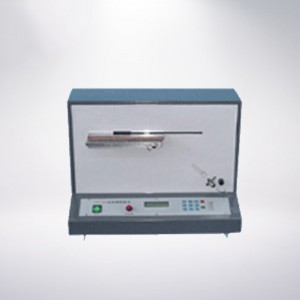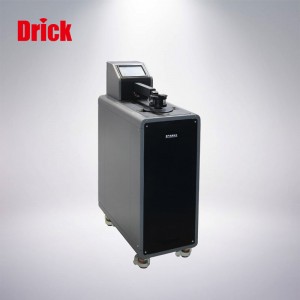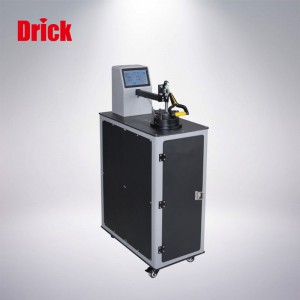DRK255-2 Textile Thermal and Moisture Resistance Tester
First. Scope of application:
DRK255-2 thermal and moisture resistance testing machine is suitable for all kinds of textile fabrics, including technical fabrics, non-woven fabrics and various other flat materials.
Second. Instrument function:
Thermal resistance and moisture resistance tester is an instrument used to measure the thermal resistance (Rct) and moisture resistance (Ret) of textiles (and other) flat materials. This instrument is used to meet the ISO 11092, ASTM F 1868 and GB/T11048-2008 “Textile Biological Comfortability Determination of Thermal Resistance and Moisture Resistance under Steady State Conditions” standards.
Third. Technical parameters:
1. Thermal resistance test range: 0-2000×10-3 (m2 •K/W)
The repeatability error is less than: ±2.5% (factory control is within ±2.0%)
(The relevant standard is within ±7.0%)
Resolution: 0.1×10-3 (m2 •K/W)
2. Moisture resistance test range: 0-700 (m2 •Pa / W)
The repeatability error is less than: ±2.5% (factory control is within ±2.0%)
(The relevant standard is within ±7.0%)
3. Temperature adjustment range of test board: 20-40℃
4. The speed of the air above the surface of the sample: Standard setting 1 m/s (adjustable)
5. Lifting range of the platform (sample thickness): 0-70mm
6. Setting range of test time: 0-9999s
7. Temperature control accuracy: ±0.1℃
8. Resolution of temperature indication: 0.1℃
9. Warm-up period: 6-99
10. Sample size: 350mm×350mm
11. Test board size: 200mm×200mm
12. Dimensions: 1050mm×1950mm×850mm (L×W×H)
13. Power supply: AC220V±10% 3300W 50Hz
Forth. Use environment:
The instrument should be placed in a place with relatively stable temperature and humidity, or in a room with general air-conditioning. Of course, it is best in a constant temperature and humidity room. The left and right sides of the instrument should be kept at least 50cm to make the air flow in and out smoothly.
4.1 Environmental temperature and humidity:
Ambient temperature: 10°C to 30°C; relative humidity: 30% to 80%, which is conducive to the stability of temperature and humidity in the microclimate.
4.2 Power requirements:
The instrument must be well grounded!
AC220V±10% 3300W 50 Hz, the maximum through current is 15A. The socket at the power supply place should be able to withstand a current of more than 15A.
4.3 There is no vibration source, no corrosive medium around, and no large air flow.
DRK255-2-Textile thermal and moisture resistance tester.jpg
Fifth. Instrument features:
5.1 The repeatability error is small;
The core part of the thermal resistance and humidity resistance testing machine-the heating control system is a special device independently developed. Theoretically, it completely eliminates the instability of the test results caused by thermal inertia. The error of the repeatability test is much smaller than the relevant standards at home and abroad. Most of the “heat transfer performance” test instruments have a repeatability error of about ±5%, and this equipment reaches ±2%. It can be said that it has solved the long-term global problem of large repeatability errors in thermal insulation instruments and reached the international advanced level.
5.2 Compact structure and strong integrity;
The heat and humidity resistance tester is a device that integrates the host and the microclimate. It can be used independently without any external devices. It is adaptable to the environment and is a heat and humidity resistance tester specially developed to reduce the use conditions.
5.3 Real-time display of “heat and humidity resistance” values
After the sample is preheated to the end, the entire “heat and moisture resistance” value stabilization process can be displayed in real time, which solves the problem of the long time for the heat and moisture resistance experiment and the inability to understand the entire process.
5.4 Highly simulated skin sweating effect;
The instrument has a highly simulated human skin (hidden) sweating effect, which is different from a test board with only a few small holes, and it satisfies the equal water vapor pressure everywhere on the test board, and the effective test area is accurate, so that the measured “moisture resistance” is closer True value.
5.5 Multi-point independent calibration;
Due to the large range of thermal and moisture resistance testing, multi-point independent calibration can effectively improve the error caused by nonlinearity and ensure the accuracy of the test.
5.6 The temperature and humidity of the microclimate are consistent with the standard control points;
Compared with similar instruments, adopting the microclimate temperature and humidity consistent with the standard control point is more in line with the “method standard”, and at the same time has higher requirements for microclimate control.
Products categories
-

Phone
-

E-mail
-

Whatsapp
-

Top








